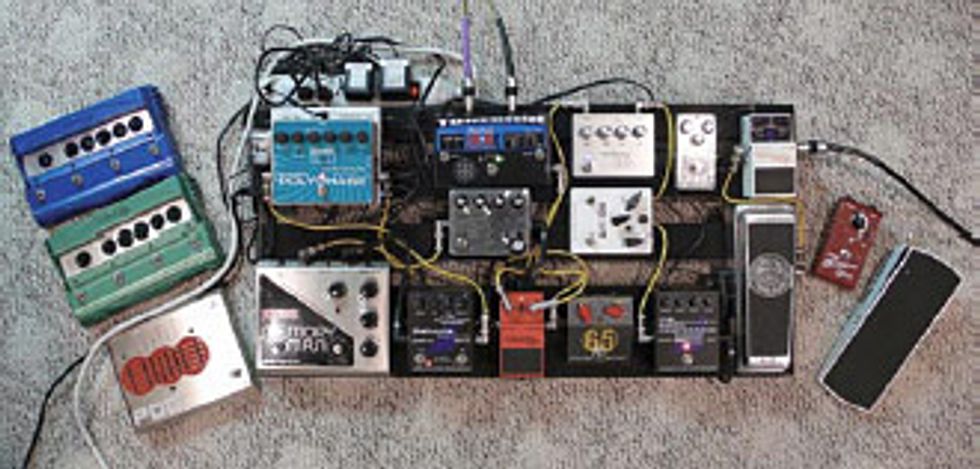Peter Stroud shows off his pedal collection.
 Over the past two issues I’ve been bragging about my stage rig, so I’ll keep it going and show off my pedalboard. These are pretty much my “go-to” pedals for a session, along with a few others I carry along.
Over the past two issues I’ve been bragging about my stage rig, so I’ll keep it going and show off my pedalboard. These are pretty much my “go-to” pedals for a session, along with a few others I carry along. The Chain
The signal chain starts with a BOSS TU-2 tuner, followed by a Moollon Wah, Carl Martin Compressor/Limiter, Pro Analog Power Driver, Boss PSM-5 (used for loop switching only), and a Radial Tonebone A/B switcher.
Looped through the Boss PSM-5 is a Moollon Chorus, EH Polyphase, Carl Martin Delayla, and an EH Memory Man.
I use the Pedaltrain PT-PRO pedalboard, a well-constructed metal frame with Velcro for mounting the pedals. It comes with a fitted ATA Rated road case with flush mounted wheels.
The power supply is an early model Juice Box, the most versatile multi-voltage power supply I’ve come across. The latest, greatest version is available at pedalgear.net.
The Details
The design of the signal chain is to run through the compressor and boost/overdrive pedals, the loop switcher for delay modulation effects, then to the A/B/Y pedal, with ability to switch between two amps. The Carl Martin Compressor and the Moollon Overdrive pedals both incorporate high quality buffer circuits, so as long as either one of these are included, I can string on as many pedals as I need – within reason – without loss of signal.
True bypass is not always a great thing, especially when you have a bunch of pedals. Even one ¡°true bypass¡± pedal can degrade your tone dramatically, as the signal gets padded by the physical connections. You need a buffer circuit in the chain to keep your signal intact. For A/B/Y switching between amps, there are two important features to have in whatever pedal you choose. The first is an isolation transformer circuit that breaks the ground between the inputs of the two amplifiers. This gets rid of any ground loop hum and buzz, allowing you to keep both amps properly AC grounded with their 3- prong connections. The second is a 180¢ª phase switch, which can correct the phase relationship between two guitar amps when run together. Besides the Radial Tonebone, these features are found in the Lehle Dual SGoS, the Framptone Switcher, and the Radial Big Shot. If you¡¯re running two amps simultaneously, you need one of these models.
The Boss PSM-5 loop switcher allows me to insert the delay/modulation effects when needed. The EH Polyphase is one of the coolest phasers to come out in a long time; it has great tone and incredible flexibility for shaping the phase wave from very mild to extreme. The Moollon Chorus pedal is one of the best sounding chorus units I’ve ever heard. It is a mono pedal that enables any amount of chorus, from soft to extreme “Leslie” type effects and even features separate wet and dry output controls.
The Rest
In addition to these, I keep a selection of others that I can switch out or place in the chain:
Seymour Duncan Pickup Booster – super clean and transparent signal booster with Class A circuitry.
65 Amps Colour Boost – great sounding treble booster-type pedal that ranges from over-the-top gagging distortion to chiming jangling clean tones all from your guitar’s volume control.
Ernie Ball Volume Control – used in just about every session and always used live.
EH POG – another great original “must have” from the Mike Matthews camp. It can be used subtly or afford organ-like effects and chord intervals. It allows one and two octaves above and below, and tracks all simultaneously.
Line 6 DL4 and MM4 Modelers – utility pedals for any sound needed at the spur of the moment. They’re great for digital delay and other vintage effects that I want, but don’t feel like carrying around.
While pedals are good for any kind of sound and texture, what can be more exciting is plugging straight into the amp and commencing to rock. You try harder to get the most out of your guitar and amp, and extend yourself more creatively. Whenever I do a gig that calls for a guitar, cord and amp, it feels like a holiday!
I’ll be a taking a break for a while from writing the column, perhaps until I’m back out on tour and have more to share with you “from the road.” Until next time, cheers!
Peter Stroud
65amps/co-founder
www.sherylcrow.com
65amps.com
